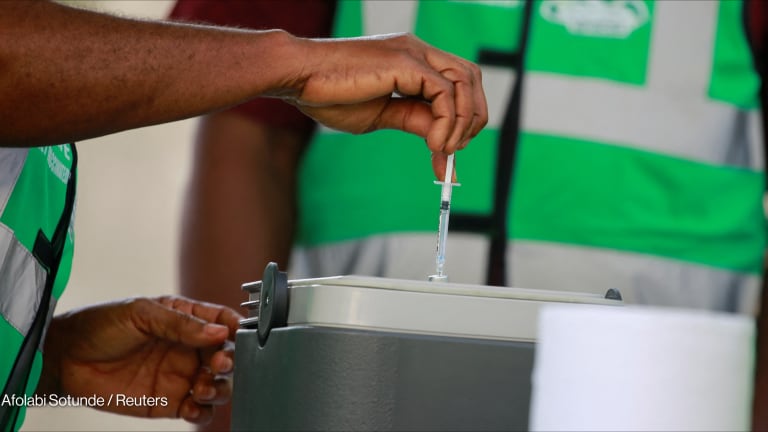
A global goal to vaccinate 70% of every country’s population by the end of June 2022 will not be reached.
As of May 31, only 58 countries and territories have done so, according to Our World in Data. Most are from high-income countries — which doesn’t include yet the United States — and none are from low-income countries. Collectively, only 16.2% of low-income countries’ population has received at least one dose of a COVID-19 vaccine.
But there has been some hard-won progress among those that started the year with less than 10% of their populations fully vaccinated, and that should also be celebrated, said Ted Chaiban, the global lead coordinator for the COVID-19 Vaccine Delivery Partnership, which was established by the World Health Organization, UNICEF, and Gavi, the Vaccine Alliance to accelerate vaccination coverage in several countries.
The Central African Republic, for example, has been able to increase coverage from 9.98% in January to 21.07% in May. It now targets to vaccinate 52% of its population by December 2022.
“If we can get countries to do the kind of progress that [the] Central African Republic has done, and as part of that progress, high coverage levels among the high priority groups, we should celebrate that. We should celebrate that countries have done well,” he told Devex.
“I think what's important is to focus on country targets first. If you're at 5% or 9% vaccine coverage, 70% is a long way away. What's important is to focus on what you have immediately set for yourself to succeed at while ensuring that high priority groups are covered,” he added.
A total of 16 out of the 34 countries that have received concerted support to accelerate vaccinations since January 2022 from the COVID-19 Vaccine Delivery Partnership have to date fully vaccinated more than 10% of their populations. These include Afghanistan and Ethiopia, both of which are dealing with humanitarian crises in their own countries. Four of them have reached at least 20% coverage, and seven are near or have surpassed country targets before the June 30 deadline.
Chaiban says the next three to four months will be critical in accelerating vaccination coverage in these countries, particularly high-risk groups such as health workers, older people, and those with underlying medical conditions.
“As we go into the last quarter of the year, a number of countries will be looking at how to integrate COVID-19 vaccination with their primary health care service and look at this as a routine. But this can and should only be done once there’s been a good opportunity to raise coverage levels and protect the most vulnerable,” he told Devex.
The window for that acceleration is critical, as countries deal with changing perceptions of COVID-19’s threat while addressing other health issues.
A total of 14 countries out of the 18 countries with below 10% vaccination coverage to date that has been receiving support from the COVID-19 Vaccine Delivery Partnership are also managing major health emergencies. That includes the Democratic Republic of Congo, where full vaccination coverage for COVID-19 continues to lag behind at 1.29% of the population. The DRC is also dealing with a new Ebola outbreak in Mbandaka, a densely populated city home to more than 1 million people.
The must-read weekly newsletter for exclusive global health news and insider insights.
“It's very important in these countries that we move forward with COVID-19 vaccination while recognizing the urgency of those humanitarian priorities. And therefore, we are encouraging a bundling of COVID-19 vaccination with other humanitarian priorities,” Chaiban said.
Demand needs to pick up
At present, COVID-19 vaccinations are already facing numerous challenges. One of which is the waning risk perception of the threat of COVID-19. In eastern and southern Africa as well as West and Central Africa, the risk perception of COVID-19 has fallen from 61.9% and 57% in January 2022 to 54.5% and 49.4% by April, respectively, according to data from The Collective Service, a risk communication and community engagement platform launched during COVID-19.
Vaccination willingness in these regions is also lowest, not just for primary vaccinations but also for booster doses. Only 37.7% of those in West and Central Africa are willing to get a booster dose, according to the same platform, with the younger population aged 18-24 years old less willing across age groups.
“Omicron has changed risk perception. It's a transmissible variant, but it was less virulent than some of its predecessors. And so it went through a lot of countries, people got sick. But they also said, ‘it came through and it passed,’” Chaiban said.
“We need to remind [people] that there's still a risk of serious illness, there's still a risk of death, especially among high priority groups,” he added.
A situational analysis by the COVID-19 Vaccine Delivery Partnership in April shows that many health workers and older people have yet to complete primary vaccinations for COVID-19, which can be one or two doses. Only an estimated 75% of targeted health workers in 64 low- and lower-middle-income countries part of the COVAX Advance Market Commitment mechanism — which receives donated vaccine doses — have completed their primary vaccination for COVID-19. In addition, only an estimated 63% of the older population in 59 COVAX AMC countries have completed theirs.
“I think what's important is to focus on country targets first. If you're at 5% or 9% vaccine coverage, 70% is a long way away. … Focus on what you have immediately set for yourself to succeed at.
— Ted Chaiban, global lead coordinator, COVID-19 Vaccine Delivery Partnership“It's very important to work with trusted community leaders, religious leaders, local mobilizers and people that are trusted by the community, trusted by the elderly, to have a discussion about why it's important to deal with this issue, which I would say is a question of enhancing vaccine demand … not just a question of vaccine hesitancy,” Chaiban said.
In early May, during an ACT-A briefing, COVAX said there’s enough vaccine supply to enable countries to meet their national vaccination targets, but demand for vaccines has been slowing down.
Need for flexible funding
Sustained funding for COVID-19 vaccination efforts, and ensuring there is readily available cash to provide countries, is important to accelerate vaccination coverage. In Chad, Chaiban said being able to quickly fund vaccination campaign needs helped increase vaccination coverage from less than 1% in January to 13%.
The health ministry wanted to do a vaccination campaign before Ramadan to increase coverage levels, and the partnership was able to provide the government with $4.9 million within five days, he said.
The Global COVID-19 vaccination effort received fresh new donor funding commitments in the past two months, first from the Break COVID Now Summit co-hosted by Gavi in April, and the next one at the second global COVID-19 summit co-hosted by the United States in early May.
But Chaiban said what’s important is to have flexible funding that they can quickly disburse to support vaccination campaigns. They are still short of $450 million to be able to continue making those quick cash injections, not just for the 34 countries receiving concerted support from the partnership, but for all 92 COVAX AMC countries.
But having the money to invest in primary health care systems is needed too, as well as maintaining global political attention to continue addressing the COVID-19 pandemic.
“COVID-19 was discussed within the context of broader pandemic preparedness, but it was ever-present during the World Health Assembly and it was an important opportunity for members to continue to commit to working on COVID-19,” Chaiban said.
“We want to continue to engage with the G-20, the African Union, and the [United Nations] General Assembly in September to continue to focus on COVID-19 and the current pandemic, even as we think about pandemic preparedness in the future,” he added.









